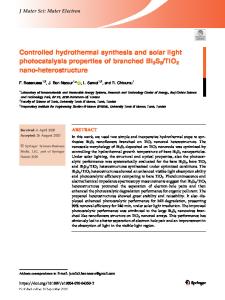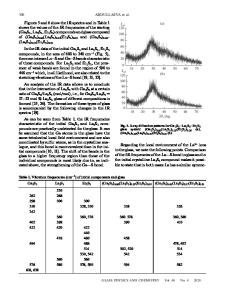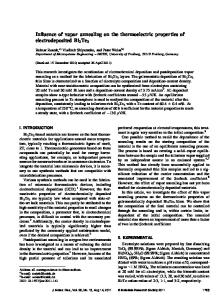Synthesis and Thermoelectric Properties of Bi 2 S 3 Nanobeads
- PDF / 653,415 Bytes
- 6 Pages / 612 x 792 pts (letter) Page_size
- 88 Downloads / 663 Views
V5.5.1
Synthesis and Thermoelectric Properties of Bi2S3 Nanobeads Jiye Fang, Feng Chen, Kevin L. Stokes, Jibao He, Jinke Tang and Charles J. O’Connor Advanced Materials Research Institute, University of New Orleans, LA 70148 E-mail: [email protected]
ABSTRACT Bismuth sulfide (Bi2S3), a direct band gap material with Eg ≅ 1.3 eV, attracts high interest in thermoelectric investigations. In this work, nanometer-sized bismuth sulfide with unique morphology has been successfully prepared by a precipitation between bismuth 2-ethylhexanoate and thioacetamide in high-temperature organic solution with presence of proper capping/ stabilizing agents. By employing this technique, we are able to produce nanobeads of bismuth sulfide with an aspect ratio of ~ 5, typically ~10 nm wide and ~50 nm long according to the TEM observation. Characterization of XRD and TEM/HRTEM reveals that the as-prepared particles exist in single orthorhombic phase and possess high crystallinity. The composite ratio between Bi and S can be adjusted by varying the ratio between two precursors and was determined by using EDS (TEM) technique. Thermoelectric properties of these bismuth sulfide nanobeads were also investigated and will be discussed comparatively with those from commercial bulk materials. INTRODUCTION Bismuth sulfide (Bi2S3) is an important member of thermoelectric materials and is a typical semiconductor as well. In bulk form, it possesses a direct band gap of Eg = 1.3 eV [1]. It is generally accepted that the band gap changes when bulk materials are transferred into nanophase due to the quantum confinement effects. It is therefore believed that the thermoelectric efficiency of nanometer-sized Bi2S3 may be apparently improved. Conventionally, Bi2S3 nanorods can be prepared by hydrothermal method [2-4], and Bi2S3 nanoparticles can be obtained using microwave irradiation [5] and thermal decomposition [6,7] routes. In this work, we employed a high temperature organic solution approach and produced, for the first time, Bi2S3 nanobeads with controlling the aspect ratio by selection of capping agent. EXPERIMENTAL The chart in Figure 1 illustrates the Material synthesis. In this approach, diphenyl ether was selected as a high boiling point reaction medium. Bismuth 2-ethylhexanoate, dissolved in diphenyl ether, was used as the bismuth precursor. Thioacetamide (TAA) was used as the precursor precipitating agent. Two part systems were prepared simultaneously. For part A, TAA (99+%, 0.8744g) was added into a round bottle flask containing 1-dodecanethiol (98+%, 4 ml), di(ethylene glycol) 2-ethylhexyl ether (98%, 2 ml) and diphenyl ether (99%, 8 ml) under argon stream. The system was gradually heated to 110 oC while being stirred untill TAA was
Downloaded from https://www.cambridge.org/core. Columbia University - Law Library, on 23 Jan 2020 at 07:57:54, subject to the Cambridge Core terms of use, available at https://www.cambridge.org/core/terms. https://doi.org/10.1557/PROC-730-V5.5
V5.5.2
completely dissolved. For part B, oleic acid (90%, 2 ml; all a
Data Loading...











